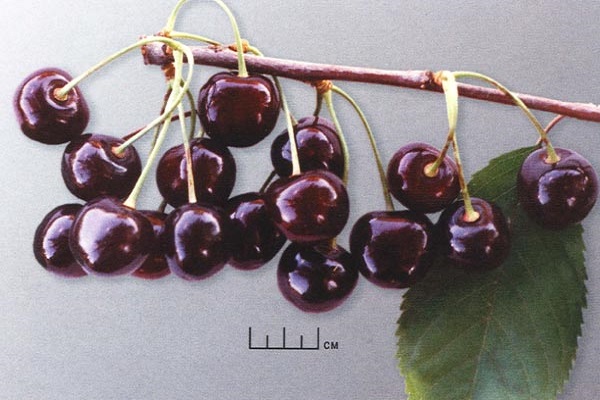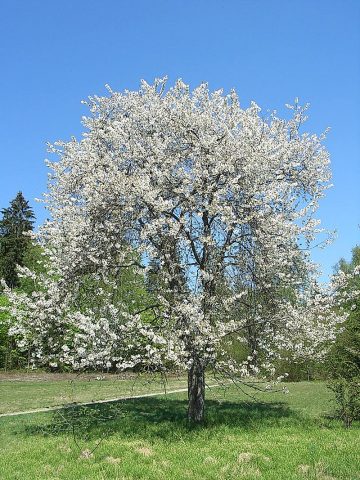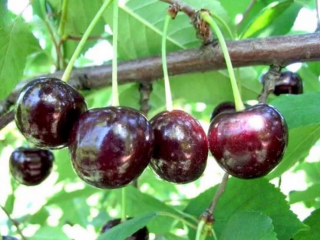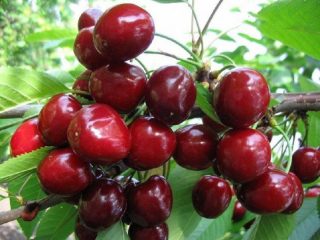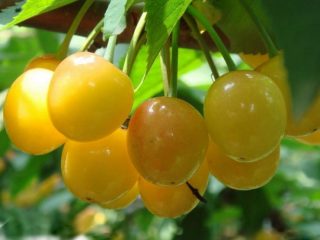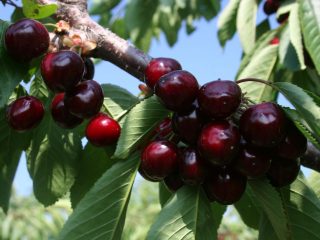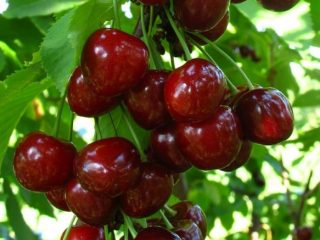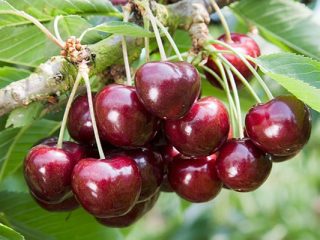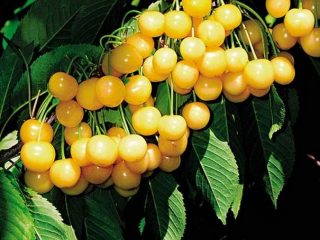Content
Cherry Rechitsa is a frequently grown variety. Ripe berries appear when other varieties have already finished bearing fruit. What needs to be done to get a decent harvest from this cherry variety.
History of selection
The variety was bred by the All-Russian Research Institute of Fruit Growing based on the Bryansk pink variety. The author is breeder M.V. Kanshina. The variety was included in the State Register in 2001. It is proposed to grow it in regions of Central Russia.
Description of culture
The tree grows quickly, the greatest height is 3 meters. The crown is not thickened, pyramidal. It has dense leaves of rich green color. The shape of the leaves is an ellipse with a pointed tip. The flowers are collected in inflorescences of three, white with yellow stamens.
Cherry varieties Rechitsa bear fruit with large round berries. The color of the fruit and its pulp is dark red. The diameter of the berries reaches 18 mm, their average weight is about 6 g.The taste of the berries is sweet, they are easily picked from the stalk, while remaining dry.
The central region of Russia, due to its climatic conditions and not too rich soils, is considered the most suitable for growing Rechitsa cherries.
Characteristics
It is worth taking a closer look at the characteristics of the Rechitsa cherry variety.
Drought resistance, frost resistance
Cherry variety Rechitsa is not a drought-resistant plant. To get a high yield you need to water every 30 days. During dry summers, this is done as soon as the soil dries out.
Rechitsa - cherry is quite winter-hardy, the freezing level is estimated at 0.2 points. This applies to both the tree and the fruit buds. Young trees are spudded and wrapped in burlap to protect them from animals.
Pollination, pollinating varieties, flowering period and ripening time
This tree cannot produce fruit without a pollinator variety. The plant is self-sterile. Pollinators for the Rechitsa variety of cherries are Ovstuzhenka, Odritsa, and Iput cherries. Cherry Rechitsa begins flowering in May, the berries become ripe by July 15-20.
Productivity, fruiting
The tree begins to bear fruit at the age of 5 years and every year thereafter. The harvest averages 30 kg per tree. The berries do not crack due to rain and hang without falling for 10 days. But you shouldn’t delay harvesting so that it doesn’t become food for birds.
Area of application of berries
The sweet berry is good fresh, as a dessert. It is used for preparing a variety of preparations. Sweet dessert liqueurs will be delicious. For winter, it is useful to freeze the berries. They do not deteriorate during transportation and can be stored refrigerated for some time.
Resistance to diseases and pests
Cherry variety Rechitsa does not suffer from many diseases characteristic of this crop. Cold, wet weather can cause rotting cankers on the fruit and blackening of the leaves.
Advantages and disadvantages
Among the advantages of the Rechitsa cherry variety are:
- High yields every year.
- Good keeping quality of fruits.
- Resistance to excessive humidity.
- Dry separation of the berries during removal.
- Resistance to diseases and pests.
- High winter hardiness.
Landing Features
Rechitsa cherries require certain growing conditions.
Recommended timing
The most preferable planting for the Rechitsa cherry variety is in the spring; it creates the opportunity for the seedling to take root reliably and strengthen itself for the winter cold. The seedling is planted three days after the soil thaws, when it is in a state of hibernation.
Autumn planting provides a large selection of seedlings. You can visually assess their condition. In the fall, you need to carefully prepare the planting site and provide the tree with reliable shelter for the winter.
Choosing a suitable location
This area should be illuminated by the sun and be located in high areas where there are no swamps or groundwater. There should be no drafts or north winds.
What crops can and cannot be planted next to cherries?
You need to avoid apple and pear trees nearby. Their powerful roots take away nutrition and moisture from the cherries. You also need to exclude linden, birch, spruce and pine from your neighbors.
Cherries do not accept eggplants, tobacco, peppers, or tomatoes next to them. Poor proximity to gooseberries and raspberries. But cherries, plums and honeysuckle will have a beneficial effect on this crop.
Selection and preparation of planting material
The best seedlings for Rechitsa cherries are those formed by grafting the variety onto a rootstock. The vaccination site must be carefully inspected. The seedling must have a healthy appearance and developed, intact roots. Its height is required to be at least a meter.
Cherry seedlings are first placed in Kornevin. Three hours is enough for the roots to be saturated with water.
Landing algorithm
Growing Rechitsa cherries begins with preparing the planting site. Make a hole measuring 60 x 60 x 60 cm. A mound of fertilized soil is placed in its center. A seedling is placed on it with its roots straightened.
Water is poured into the hole and the roots are covered with soil. The grafting site is left at soil level without filling it up. The soil is lightly compacted to remove air. The tree trunk circle is mulched with humus.
There is a gap of at least 3 meters between the trees. When several rows are formed, a distance of 4-5 meters is left between them.
Subsequent care of the crop
The main care for Rechitsa cherries consists of organizing watering, applying fertilizers, and pruning. The crop requires watering in the spring during flowering. For young plantings, pour 30 liters of water under each tree. An adult, yielding plant requires 60 liters.
Dry soil will serve as a signal for mandatory watering, but there is no need to bring it to this state.
Trees will need to be fed after the first winter. Seedlings need nitrogen fertilizer. At this time, you should add 100 g of urea per 1 square meter. meter. In subsequent years, complex mineral fertilizers or humus are applied. Ash is a must; it enriches the soil with potassium and reduces its acidity.
It is imperative to shape the tree. Of the large branches, one main trunk is left. The rest should be removed. If the main trunk is damaged, a replacement trunk is allowed to develop.
After winter, remove broken and thickening branches. This is the so-called sanitary pruning. The sections are washed with copper sulfate and covered with garden putty.
The Rechitsa cherry tree does not need winter shelter. Only young seedlings should be insulated and protected from rodents. Shortly before frost, the soil around them is mulched. The tree is protected with spruce branches and tied with a rope. To better imagine what kind of culture cherry is, you can watch the video:
Diseases and pests, methods of control and prevention
Diseases | Description | Control measures |
Moniliosis | The berries begin to rot, the flowers and ovaries fall off. The fruits are covered with gray growths. The disease leads to the death of the entire plant | Treating the entire tree and soil around with Bordeaux mixture in spring and autumn. Do not thicken the crown, remove diseased parts of the tree |
Coccomycosis | It is caused by high humidity and frequent cold rains. The leaves become covered with individual brown spots, which gradually cover the entire surface of the leaf. Shedding of leaves and fruits occurs | Destruction of diseased branches by burning. Treat trees with Nitrophen solution |
Pests | Description | Control measures |
Cherry sawfly | A small black bug with yellow stripes. Its caterpillars eat leaves and buds. When there are a large number of them, the tree remains bare | Spraying with “Karbofos”, “Phosfamide”, “Aktara” |
Cherry pipe beetle
| The leaves curl and beetle larvae settle in them. The beetle itself eats flower buds, which reduces the harvest | Use remedies similar to those used against the sawfly |
Conclusion
Cherry Rechitsa deserves to create a cherry orchard on a garden plot. It will not require much attention, but by planting cherries, you can please your loved ones with a tasty and healthy berry. A garden blooming in spring will create a festive mood.

